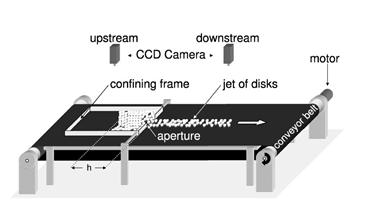The Mystery of Sand Flow Through an Hourglass
Physicists have long known that the flow of sand through an hourglass is entirely different from the flow of liquid. In the case of a liquid, the rate of discharge depends on the pressure at the aperture which is determined by the height of the liquid above.

But things are different in granular media. In 1895, a German engineer called Janssen discovered that the pressure at the bottom of a container of granules does not depend on the height of the grains above. He reasoned that the grains form chains and bridges that transmit their weight to the side of the container where they are supported by friction. So the pressure increases asymptotically with depth up to a threshold.
In fact, if the height of the granules is twice that of the width of the container, the pressure at the bottom is effectively constant. It is this constant bottom pressure that Janssen and others have always assumed determines the mass flow out of the aperture in an hourglass.
Not so, say Maria Aguirre at the University of Buenos Aires in Argentina and a few friends who have carried out an experiment to test this idea.
Their idea is to take gravity out of the equation by placing the granules, or in this case small discs, on a conveyor belt which carries them through an aperture (see diagram above). This allows them to alter the exit velocity of the discs through the aperture by changing the speed of the belt.
The results throw up a surprise: they show that with the same bottom pressure it is possible to get different flow rates simply by changing the speed of the conveyor belt. That means it is the speed of the discs that determine the flow rate, not the bottom pressure.
That’s a subtle but important result. Janssen’s effect has been studied in detail for more than 50 years without anybody questioning the thinking behind it.
And it could have interesting practical applications. The new work suggests that it ought to be possible to increase the flow of particles through an aperture by increasing their velocity through it. That could be done with electric fields, for example, or with solid or liquid conveyor belts like the ones used by the Argentinian team.
That should be useful in the numerous industries where particles have to be mixed together in a repeatable way, such as the food, drug and construction industries.
But for those worried about soft boiled eggs, it shouldn’t effect the flow of sand through an hourglass.
Ref: arxiv.org/abs/1005.2884: Pressure Independence Of Granular Flow Through An Aperture
Deep Dive
Policy
Is there anything more fascinating than a hidden world?
Some hidden worlds--whether in space, deep in the ocean, or in the form of waves or microbes--remain stubbornly unseen. Here's how technology is being used to reveal them.
A brief, weird history of brainwashing
L. Ron Hubbard, Operation Midnight Climax, and stochastic terrorism—the race for mind control changed America forever.
What Luddites can teach us about resisting an automated future
Opposing technology isn’t antithetical to progress.
Africa’s push to regulate AI starts now
AI is expanding across the continent and new policies are taking shape. But poor digital infrastructure and regulatory bottlenecks could slow adoption.
Stay connected
Get the latest updates from
MIT Technology Review
Discover special offers, top stories, upcoming events, and more.